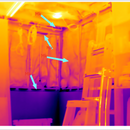Above-grade basement wall air sealing and insulation
I have a 1920s house (Boston area, zone 5a) with a 1990s addition that gives my basement the trifecta – fieldstone in the front, concrete block as it emerges above grade (not sure when/how/why that happened), and poured concrete on the addition which walks out to the rear.
The fieldstone/block sections are totally uninsulated and only partially air-sealed, but that’s a separate project (but a project we’re planning to do to help lower our air infiltration and stack effect problems).
Below is an IR photo of the rear/addition basement wall, which has a 4′ poured concrete wall beneath studs. It was taken with outside temps at 17F.
The studs have R13 fiberglass batts in them, which appears to be at least moderately effective with just some minor drafts, though the paper faces could probably stand to be stapled over the studs to help with a little of the bridging and perhaps some of the draft.
It looks like there was a leveling issue when the addition was built, and there are shims every 6-8 inches between the sill and the base of the studwall. The gaps between those shims is letting in a ton of air in, which often could be described as a breeze.
What’s worth doing here? This section is a workshop, so I’m not looking to “finish” it,
My thought was something like 2-2.5″ polyiso over the concrete – maybe thermax or r-max to avoid having to finish it. Is there value in an additional 1″ of polyiso for the studded area? That’d involve box extenders for the outlets/switches on that wall and maybe moving the pipe for that outdoor hose bib you can see in the image. Finally, I’d bridge the studded area and the concrete/polyiso across the sill with ccSPF to seal that all up and paint on an ignition barrier.
Is it likely worth it? Should I instead just get some great stuff/titefoam, fill the gaps, and call it a day? I’m also new to posting on here, but have learned a ton from reading over the last few weeks (I’m under no illusions that I’m not a noob). Thanks for the thoughts!
GBA Detail Library
A collection of one thousand construction details organized by climate and house part










Replies
Jackson,
Using a few cans of spray foam would certainly reduce the air infiltration? If there is no capillary break at the sill, you might want to address that first.
Have you read this article? https://www.greenbuildingadvisor.com/article/how-to-insulate-a-basement-wall